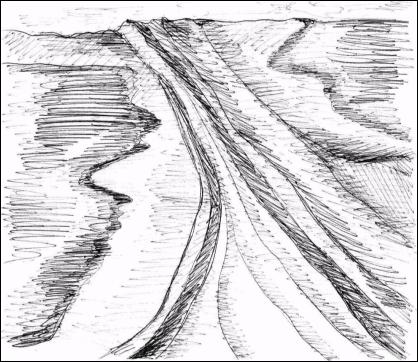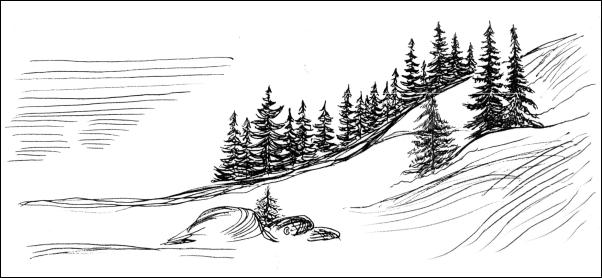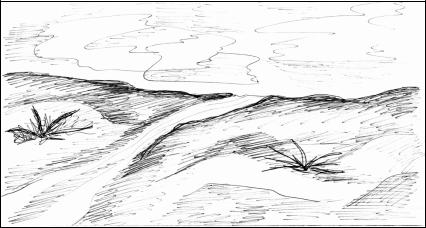
2579
.pdf
Text 2
14. Read the following words and learn them by heart:
Arctic circle – Северный полярный круг stern – суровый
wilderness – пустыня flock – стая
swamp – болото lichens – лишайник willow – ива
15.What climatic zones do you know? What kinds of vegetation are typical for them?
16.Look at the title of the text. What do you think it is about? Say words you expect to find in it.
17.Read the text and try to formulate the main idea of the author:
IN THE ARCTIC CIRCLE
Tundra stretches in a narrow belt along the coast of the Arctic Ocean, occupying the lowland area of the Extreme North of Siberia. Nature is stern in the Arctic Circle: the seas of the Arctic Ocean are icebound for nine months in the year, and the polar night with its snowstorms and severe frosts reigns supreme for most of the year. The expanses of snowblanketed wilderness
seem to be boundless. From time to time the dark, cold sky is illumined by the twinkling Northern Lights. The land is wrapped in unbroken silence. This makes
10
the landscape at once monotonous and awe-inspiring. Such is the tundra in winter. But everything changes with the approach of spring: the grass blossoms up with bright colours, and when summer is near countless flocks of birds congregate in the numerous swamps and lakes, filling the air with their loud cries. Only an inconsiderable top layer of the frozen ground thaws out during the short and cold summer. That is why there are no trees in the tundra and the only vegetation consists of moss, lichens, berries and mushrooms. Stunted willows and birches, forming a kind of shrubbery, appear farther south, amid the numerous swamps.
For ages the area within the Arctic Circle was the most forsaken wilderness of tsarist Russia. In Soviet years this area saw the appearance of ports, large towns, numerous settlements, reindeer-breeding and fishing farms, fishing and canning industries, and hundreds of schools, hospitals and veterinary stations. Caravans of ships ply the Northern Sea Route along the coast of Siberia, and far within the Arctic Circle stands Norilsk, the northernmost Russian city with its handsome buildings and broad streets lit by electricity continuously throughout the long polar night. In addition to their old occupations – reindeer-breeding, hunting and fishing – the population now has many new ones linked up with the mining of coal, ores and nonferrous and rare metals. The development of metallurgy and other industries, the advance of science and culture, and, in recent years, agriculture and dairy-farming. Books, newspapers, magazines and the radio have entered the life of the former nomad reindeer-breeders.
18. Find in the right column the meaning of the words given in the left column:
1. wilderness |
a) мерцать |
2. boundless |
b) болото |
3. swamp |
c) безграничный |
4. dairy-farming |
d) молочная ферма |
5. stern |
e) стая |
6. flock |
f) суровый |
7. twinkle |
g) пустыня |
19.Put the verb into a correct form:
1.Tundra … (occupy) the area of Extreme North of Siberia.
2.Northern lights … (illuminate) the dark sky.
3.The air … (fill) with loud cries of birds in summer.
4.In the 20th century large towns and ports … (appear) in this region.
5.Mineral resources of tundra … (include) coal and ores of nonferrous and rare metals.
11
6.Reindeer-breeding, hunting and fishing … (be) traditional occupations of the population.
20.Give an adjective with the suffix –less for each of the following words and translate them:
care, colour, help, hope, thought, use
What Russian affix is used to express the same meaning as –less?
21. Fill in the correct words from the list below using each word only once:
narrow, trees, seem, books, metallurgy
1.a ... belt
2.there are no ... in the tundra
3.... to be boundless
4.the development of ...
5.... have entered the life
22.Work in two teams. Take it in turns to choose words from the list and make sentences. Each correct answer gets one point. The team with the most points is the winner:
the cost of the Artic Ocean; nature is stern; polar night, severe frosts: reign, dark sky, unbroken silence, with bright colours, flocks of birds, occupy, fill, loud cries, saw, appear, swamp.
23.Find the sentences in the text proving that:
1.Nature is stern in the tundra and the only vegetation consists of moss, lichens, berries and mushrooms.
2.The landscape monotonous and awe-inspiring.
24.Work in pairs. Ask your partner to tell you about the tundra in winter and in spring. Use the following phrases:
Could you please tell me about ...
Can I speak you a question concerning ...
With great pleasure.
Certainly.
I see, thank you.
12
25. Give the English equivalents:
казаться безграничным; время от времени;
споявлением весны; бесчисленные стаи птиц;
сгромким криком;
споявлением многочисленных поселений; полярная ночь; развитие металлургической промышленности; в прежние времена.
26.Which of these facts prove that: a) the sphere of human activity within the Arctic Circle is widening constantly; b) the Arctic Circle is rich in different types of resources?
1.In 1923 there was nothing but a winter lodge with several auxiliary structures. Today Dickson is a large Arctic port and one of the principal stations along the North Sea Route.
2.Fleet-footed reindeer are a vital part of life in these regions. The inhabitants of the tundra use their skins for clothes, yurtas and the manufacture of the finest chamois, and their meat for food.
3.The polar fox with its lovely fur is an indigenous inhabitant of the tundra. When the rigorous polar winter drives all the animals and birds from the tundra, he is one of the few to remain behind amid the lifeless snowbound plains.
4.Boarding schools, where the children of the Nentsi, Dolgans and other peoples of the North study, have been opened within the Arctic Circle.
5.The handsome town of Norilsk sprang up in a region of permafrost, polar nights and blizzards less than thirty years ago. It is one of the northernmost towns in the world. With its modern multi-storey buildings, straight asphalted roads, green squares and flowerbeds; it is a centre of industry and culture.
6.The Ob is one of the longest rivers in the world.
7.The mines of this region produce the ores of many valuable metals.
8.In the south of the Arctic Circle the vast tundra gradually gives way to forests.
9.There are many fur farms or "soft gold" factories of the Arctic Circle. They breed the most valuable fur animals – the silver fox, the blue fox, the mink and the sable.
13

27. Your friend has just returned from Tundra. Ask him about his impressions. Make up a dialogue, using the following:
Where did you go? – I went ...
What did you see there? – I saw ...
What did you visit? – I visited ...
What did you like? – I like ....
28. Make a story describing the traditional way of life of native peoples in the Arctic Circle.
Text 3
29. Read the following words and learn them by heart:
fir – ель, пихта aspen – осина cedar – кедр
larch – лиственница dense – густой
abundance – избыток, изобилие timber – лес
30. How does the title relate to the picture?
Would you like to visit it? Why? What do you know about the animals living there?
14
31. Compare the following description of taiga with the previous one of tundra. What makes taiga more convenient for living than tundra?
IN THE TAIGA
No forest in the world can compare with the Siberian taiga. You can fly for hours on end over this great and lovely sea of foliage. Even an attentive person will not notice any break in the monotony of the landscape before him, and yet the taiga is varied. In the West Siberian Lowland it is dark and damp, consisting mainly of fir with an admixture of aspens and cedar. This is called the black or dark-coniferous taiga. Beyond the Yenisei on the high and dry MidSiberian Plateau, the larch is the principal tree in the forests. In these forests the trees are not so dense and their beautiful crowns let through an abundance of sunlight. This is the domain of the bright-leafed larch forests. Farther to the east of the Lena, the taiga retreats to the south, while along its northern boundary the forests become sparser. Nature has endowed the taiga with a generous share of wealth.
There are huge reserves of timber, coal and iron ore. The coal reserves in the Kansk-Achinsk Basin are estimated at 1000 000 million tons, while the ironore deposit along the middle reaches of the Angara contains enough metal to girdle the earth 60 times with steel tracks. The time has long passed when the taiga was only a source of fur. Today it is an important region of the timber, mining, engineering and chemical industries. Large-scale construction has been started, and the projects include such giant metallurgical plants as oreconcentrating mills at Korshunovo, aluminium factories at Irkutsk and Krasnoyarsk and also the world's biggest hydropower stations at Bratsk and Krasnoyarsk, big thermal power stations, and the new Achinsk-Abalakovo and Abakan-Taishet railways. The tall towers of high-tension electric transmission lines are penetrating ever deeper into the taiga. Bashkirian oil flows across Siberia through nearly 4000 kilometres of pipeline. Many new settlements and modern towns have sprung up in the taiga in recent years. Among them are Angarsk, Bratsk, Zhelesnogorsk (near the recently-discovered Angara-Ilim iron-ore deposits) and Mirny (standing in the heart of the diamond-bearing region). This unbelievably beautiful and rich region is really worth exploring.
32.Which of the following statements are not true?
1.The main trees of taiga forest are firs, aspens, cedars, and larches.
2.All the taiga forests are very dark and damp.
3.Fur still remains the main resource of Siberia.
4.Russia's largest reserves of timber are in taiga.
5.The cities in taiga were built near the deposits of different minerals.
15
6.The population here is as dense as in Europe.
7.The main industries are timber, mining, engineering and chemical.
8.Taiga has great energy resources.
33.Give equivalents in English:
1.широкомасштабное строительство
2.линии электропередач
3.хвойный лес
4.море растительности
5.Природа одарила тайгу большой долей богатства.
6.Давно прошло то время, когда тайга была только источником мехов.
7.Дальше на восток от Лены тайга отступает на юг.
8.Много новых поселений выросло в тайге в последние годы.
9.Этот район стоит исследовать.
34.Find an antonym for each of the following words:
dry – sparse – huge – dark – monotony –
35. Explain the difference between the following words and write a sentence with each for illustration:
reserve – deposit huge – numerous boundary – end forest – shrubbery timber – tree
36. Fill in the correct word(s) from the list below. Use the phrases to make sentences:
foliage, compare, called, fir, larch forests, sunlight
1. ... with the Siberian taiga
2.sea of ...
3.consisting of ...
4.this is ... the black taiga
16
5.abundance of ...
6.this is the domain of ...
37.Fill in the gaps with the words from the text:
1.No forest in the word can ... with the Siberian taiga.
2.You can fly for hours on end over this ... sea of foliage.
3.Nature has endowed the taiga ... a generous share of ...
4.There are huge ... of timber, coal and iron ore.
38.Make some sentences of your own with these expressions:
to be compared with to consist of
an abundance of sunlight to retreat to the south to penetrate into the taiga
39.Questions for discussion:
1.For a long time taiga was only a source of fur. Why? Give several reasons.
2.Which of these factors are still important nowadays?
3.Why is it an important region of timber, mining, chemical engineering industries today?
4.Why is this rich region worth exploring?
40.Choose a partner and make up a dialogue using the following expressions from the text:
to compare with the Siberian taiga;
to notice and break in the monotony of the landscape; to be varied;
to consist of fir with an admixture of aspens and cedar; to be called the black or dark – coniferous taiga;
an abundance of sunlight; to the east of the Lena.
41.Make up a story or a report on one of the suggested topics:
1.The lovely and great sea of foliage.
2.An important region of the timber, mining, chemical industries.
17

Text 4
42. Look at the picture. What do you think the text is going to be about? What do you know about the topic? Think of as many words as possible related to "The Steppe".
43. In teams use the words below to make sentences. Each correct sentence gets one point.
birch, aspen, rustle, gust, grove, fertile, chestnut soil, crop, yield, giant grain, wheat, maize, producer, on a big scale, industrial development, abundance, farm produce in the country, grain
44. Read the following words and learn them by heart:
expanses – пространство, протяжение birch – береза
aspen – осина
(to) scatter – разбрасывать rustling – шелест, шорох undulating – волнистый gust –порыв ветра plough-land – пахотная земля grove – роща, лесок
fertile – плодородный crop – урожай хлеба yield – приносить урожай maize – кукуруза
dairy – молочная ферма, маслодельня proceed – продолжать
junction – соединение, железнодорожный узел verdant – зеленеющий, зеленый
contribution – вклад abundance – избыток, изобилие
granary –амбар, зернохранилище
18
45. Read the text and think how many parts can be distinguished in it. What are the main points of interest for the author?
IN A LIMITLESS STEPPE
The forest-steppe and steppe are the most highly developed and densely populated regions of Siberia. They occupy a particularly large area in the southern part of the West Siberian Lowland and in the plains of the Altai foothills.
In the steppe one feels surrounded by vast expanses. The horizon is broken only here and there by small groves of birch-trees and asps scattered about the steppe. Not long ago there was nothing here but thick grass rustling and undulating in the sharp gusts of wind and breaking into flower in spring, but today tens of kilometres are occupied by plough-land. Farther south the groves disappear and the landscape becomes more open. It is drier and hotter here, and the grass is therefore sparser.
In this part of Siberia the natural conditions – the fertile black and darkchestnut soils and the fairly long vegetative period (160-170 days) – are the most favourable for agriculture. During Soviet years the crop area in the steppes of Southern Siberia has been considerably extended, the efficiency of farming raised, a high level of mechanization achieved at the farms and the yield increased. Giant grain farms have been organized to work the millions of hectares of newly-developed land. Today this is a territory of wheat, maize, dairy farming and butter. The southern steppes of Siberia are Russia's biggest producer of spring wheat of the highest quality and also of butter. Industrial development is also proceeding on a big scale in Siberia's southern steppes.
Novosibirsk, the "capital" of Siberia, is the biggest of the cities in the for- est-steppe and steppe belt. It is the third biggest city in Russia after Moscow and St. Petersburg. It has 50 research institutes and 12 institutions of higher learning. The Novosibirsk Opera and Ballet Theatre is nationally famous. Its industries now produce as many machines and various other equipment as did the whole of tsarist Russia.
After Novosibirsk, Omsk is the largest city in Siberia. It is an important junction on the Trans-Siberian Railway and also a busy port on the Irtysh. An industrial centre and the most verdant city in Siberia, it has 80 gardens and squares.
Siberia's farms are expected to make a large contribution to the creation of an abundance of farm produce in the country. Their objective is to produce 56 million tons of grain, more than 3 500 000 tons of meat and large quantities of other farm produce annually. The principal role in achieving this objective is played by Siberia's granary – its forest-steppe and steppe regions.
19
